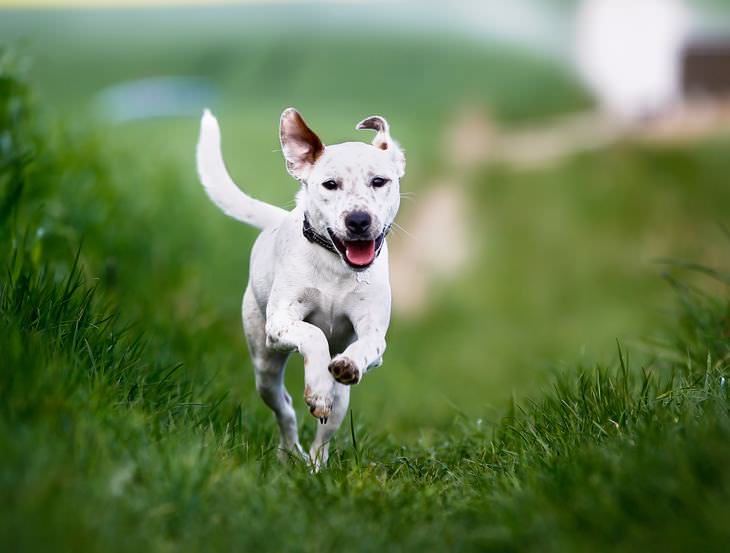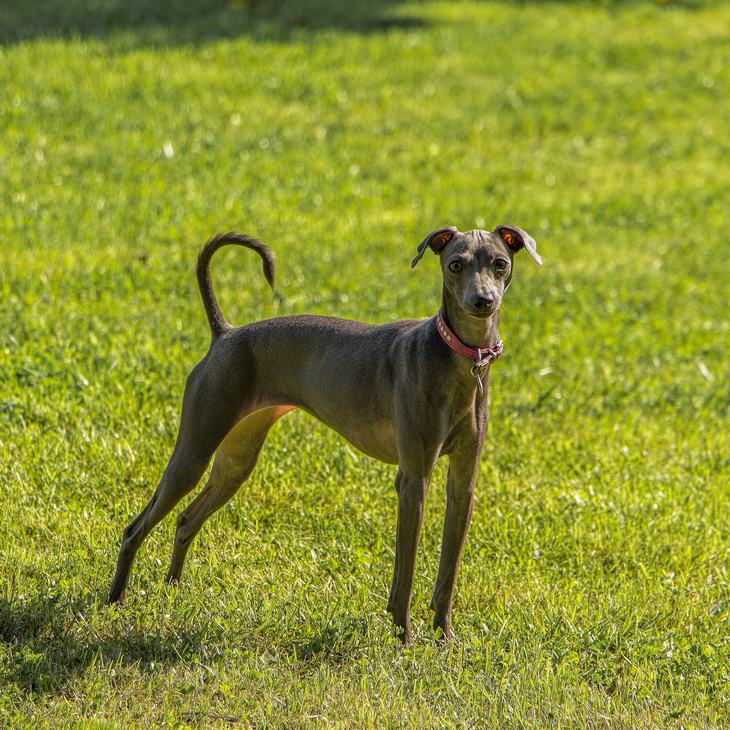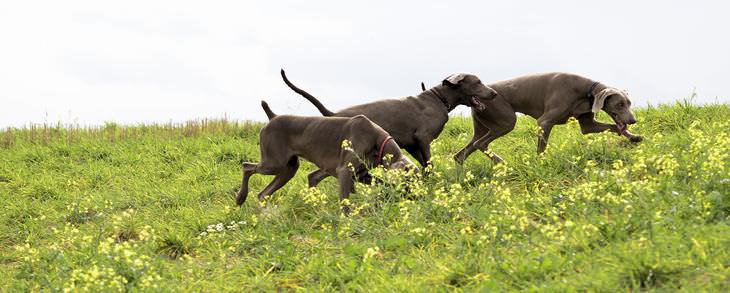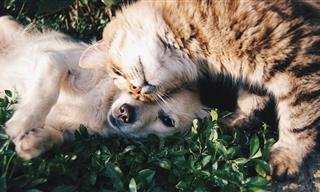

Full body wag
You're probably familiar with this wag, which you likely see whenever you come home from work. Here, your pup welcomes you with tail wagging in a big circle. He'll also shake his entire body in a loose way accompanied by a submissive grin or a soft open mouth. If you notice a lot of swaying and wiggly motion closer to the head of the dog, the friendlier the dog is.
Fast and shaky
If you notice fast, vigorous and an almost shaking tail on a dog this is a sign of tension and/or hostility. This means that the dog can spring into action at any moment. This tail behavior indicates a highly aroused dog and should generally be avoided until it settles down.
Slow wag
This can almost be seen on its face: your dog seems to be contemplating his next move. A slow wagging tail may indicate a dog that is unfriendly, so proceed with caution and take the entire environment and personality of the dog into consideration. If it's an unknown dog, do not interact with it.

High and stiff
A high and stiff tail with fast wagging means that the dog is alert and aroused. He is confident and enthusiastic. If other dogs are near it could mean a display of dominance. If a high stiff tail is combined with any teeth, open mouth, raised hackles and a wrinkled nose, take it as a cue to back off, providing them with space to make them feel comfortable and confident.
Wagin' on the right
Research suggests that when a dog wags its tail on the right side, it's considered more likely to be friendly than when a dog wags its tail on the left side of its body. Researchers discovered that dogs tend to wag their tails on the right when they wanted to approach something, like their owner, but wagged their tails on the left when they were unsure of something.
Pulled down
A tail that is held at a low level, often covering the dog's anus, but not disappearing between the legs, indicates that he is not entirely comfortable with the situation he is in and could be feeling anxious, nervous or unsure. A tail wag or wiggle may also indicate a sign of appeasement.

Tucked in
This is slightly different from a pulled down tail. When the tail is between its legs, the dog is feeling threatened or fearful of the situation he is in.
Curled toward the head
Prior to deciphering what this cue means, there are a few things to take into consideration. Some tails are naturally curled or bend towards the head, so the dog could be relaxed. But if the tail is being held (or pulled) in the direction of the dog's head, it could indicate the dog is overstimulated, on high alert, or highly excited. It could indicate alarm or exaggerated joy, which is why watching the rest of the body language the dog is showing you is important to understand how the dog is feeling.
Limp tail
A dog's tail serves a purpose. It is an extension of its backbone with vertebrae and a sensitive part of a dog's anatomy that is prone to injury. So if a dog's tail cannot wag it can mean that the dog has an injury directly to the tail, or to other connected areas. A tail can be sprained, broken, dislocated or have never damage that may cause it to go limp. It's important to seek immediate veterinary care as damage to the tail can cause incontinence, balance issues and the inability to use the tail to communicate.
What about stubby tails?
Breeds with stubby or curly tails mimic the same signals as those with straight or long tails but do not do so in the same exaggerated way as those with longer tails. Notice the base of the tail for more cues.

Save Your Dog from Choking with This Emergency Maneuver
What do you do if you see a dog choking? This guide explains all you need to know.

Why You Need to Avoid Palm Oil Right Away!
Palm oil is harmful to the environment. Here's what to do about it.

Bet You Never Knew How Beneficial These Foods Are
Include these 12 foods in your diet to reduce the effects of arthritis - they have been shown to fight inflammation, strengthen bones and boost the immune system.

Suffer From Knee Pain? Here Are 6 Moves You Can Do
Banish knee pain today with these 6 exercises.

5 Turmeric-Based Facial Masks For Removing Hair
Turmeric is a wonderful spice from India that has a whole myriad of different applications. Here's how to make 5 turmeric-based masks for unwanted hair removal.

Discover the Effects of Drinking Dirty, Contaminated Water
How safe is it to drink contaminated water? Find out here.

DIY: 12 Ways to Give Your Plastic Bottles New Life
Recycling is good but did you know there are lots of other things you can do with plastic bottles? Here are 12 ideas for do-it-yourself projects to create masterpieces out of junk.

How to Stop Worrying and End Anxious Thoughts at Night
Are anxious thoughts hindering your sleep every night? Here’s what you can do.
 7:40
7:40
Learn These 5 Kitchen Tips from a World-Class Master Chef
Here are 5 unmissable kitchen tips that will transform your cooking experience. They should have taught us useful information like this at school.

All 11 of These Ordinary Items Have Clever Hidden Features
Not only is it fun to find out the purpose of these secret features, but it’s also quite useful to know them!

Have You Been Making These Toilet Paper Mistakes Too?
The next time you use toilet paper, avoid these mistakes.

These Handy Stand Mixer Tips Made A Massive Difference...
A cooking mixer is an important appliance in any kitchen. If you employ these 9 tips, we guarantee you'll fall in love with your even more.

Who Knew That Aluminum Foil Had So Many Extra Uses?!
How much use do you get out of your aluminum foil roll? Not much? Here are 16 extra uses you have probably never heard of.

9 Genius Ideas For Keeping Your Food Fresh For Longer
These great and simple storage tips will help you keep your food fresher for longer, and save you some extra trips to the grocery store!

This is Why Paper Towels Are an Invaluable Necessity
If you're only using your paper towels to mop up the occasional kitchen accident, you're sure missing out. Here are 6 other uses for paper towels.

9 Tips to Organize Your Kitchen for Weight-Loss Success
Looking to lose weight? Start by organizing your kitchen first.

11 Ways You May Be Messing up Your Garden
Many aspiring gardeners give up on their dream, solely because they lack information about their garden. Here are 11 common gardening mistakes that we make.

So You Think You Shop Online Safely? This May Surprise You
If you shop online, you need to know how to avoid fake websites and low quality goods. For these and more online shopping tips, read this article.

12 Surprising Ways to Use Your Swiffer Around the House
These Swiffer hacks will change your cleaning routine.

This Guy Found a Tip Book from the 60s, And It's Genius!
It turns out lifehacks aren't only a thing of the present, the 60's had their own book of tips and tricks to make life easier, and here are 8 of the best!
 2:04
2:04
Did You Know There’s an Optimal Time for a Cup of Coffee?
Learn when to drink your coffee for it to give you the best pick-me-up.

I've Discovered Conditioner Has Many Other Talents...
Hair conditioner can do a lot more than just make your hair shiny...

Ten Things You Can Do With Sugar You Never Knew About
Sugar can do a whole lot more than just make things sweet.

Items You Keep on the Kitchen Counter But Really Shouldn’t
Do you keep a knife holder on the kitchen counter? What about a jar with coffee or spices? Learn why that’s probably a bad idea...

Why These 8 Purchases Shouldn't Be on Installments
Using "Buy Now, Pay Later" services may not such a good idea for these items.

When on a Flight, Avoid These 8 Things....
To help you stay healthy and comfortable during your next flight, here are some crucial tips to keep in mind.

Make Your Daily Life Easier with These Great Home Tips!
Here are 22 easy to apply tricks will make your life hassle free. Some of them are so simple you’ll wonder why you didn't think of them first.

This is One Useful Oil You Always Want to Keep Around
This article will share six different and particularly effective uses for sesame oil, which make it clear why every home should have this essential ingredient.
 1:30
1:30
This Is How to Effortlessly Clean Copper Pans
Make your copper pots and pans look brand new once again, using only some household supplies that you've probably got laying around at home.

Keep Your Lemons Fresh for Longer with These Hacks
Have you tried these lemon storage hacks yet?

Eye Wrinkles Can Be Smoothed. Just Use These Methods...
Although they are often called "laugh lines," eye-wrinkles don't make us smile or laugh. With these 10 natural remedies, you can easily eliminate them.

12 New Things You Can Learn For Free From YouTube
Looking to learn something new? Learn some useful new skills with YouTube.

14 Little Known Ways to Save on Gas While Driving!
If you take heed of these 14 easy pieces of advice, you will end up saving hundreds of dollars each year on gas.

8 Surprising Ways Vinegar Can Help With Pet Care
From being a natural flea remedy to cleaning the aquarium, vinegar proves to be an excellent option for taking care of your pets.

How to Use Ice Cube Trays to Make Delicious Dishes!
I had no idea there were such creative and delicious uses for the ice cube tray!

10 Signs You Have a High Level of Intelligence
If you find yourself relating to these characteristics, it is possible that you possess an exceptional level of intelligence...

These Tricks Will Make Dust a Thing of the Past!
Dust can gather before you can even notice it. It can cause allergic reactions and even lower the strength of your immune system. So make sure to give these tricks a try to keep your house dust-free

10 Kitchen Tips That Will Turn You into a Culinary Master
The following 10 kitchen tips will take you one step closer to becoming a culinary god.

Impress Your Kids & Grandchildren With These DIY Toys
Whether you're looking for a new hobby or a way to save yourself a fortune on kids' toys and activities, this video box has certainly got you covered!

Guide: How to Use Rising Interest Rates to Your Benefit
Consider these tips to meet your investment goals when rates are rising.

9 Ingredients It's Best to Avoid When Grocery Shopping
Stay healthy by making sure that these 9 ingredients are not part of the food you buy.

Hard Water - 9 Ways It Affects You and Your Home!
Not all water is the same. Hard water can have a negative effect on your budget, home, garden, and even your body.
 20:57
20:57
22 Smart Ways of Using Old Things Around the House
This great tips video will save you money by teaching you how to use those old items around the house in a new way.

11 Fantastic Methods for Removing Those Grease Stains!
Grease stains can be notoriously difficult to remove, but that will be a thing of the past if you use these 11 fantastic grease-removal methods.

12 Ways You Unintentionally Might Be Damaging Your Home
We all want to avoid costly repairs. Check out this list of 12 common housekeeping mistakes that can damage your home, and what to do instead.

Drilling Holes In Your Bin Can Make Your Life Much Easier!
Drilling holes in your trash can? Yes! Learn two easy tricks that will make taking out the trash much easier

Locked Your Keys inside Your Car? You Need This Hack!
If you've locked yourself out of your car, this neat trick will help you solve your problem.


